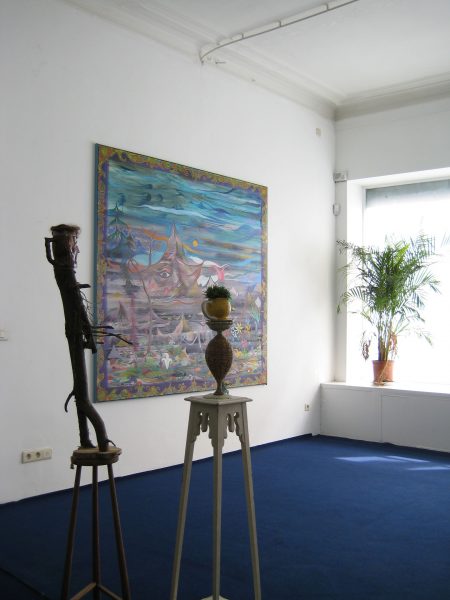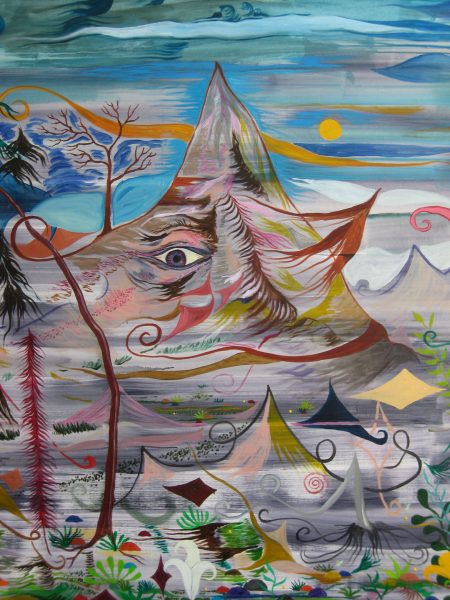OPENING
FRIDAY 21.05.10 AT 7PM
EXHIBITION
22.05.10 – 10.07.10
AND
PEPTEM SERMONES AD MORTUOS
PAUL LABRECQUE – DANIEL TSCHERNICH – ABEL AUER
On the landscape paintings by Abel Auer
Abel Auer’s landscapes are visionary because they are simultaneously forward looking and backward thinking, which is perhaps the psychedelic essence of the work. Auer’s landscapes actually relate to traditional heimat/landscape painting, like zombies to the living; a travesty of nature. They are landscapes that behave like gaudy corpses, whereby silhouettes and outlines in saturated colours are detached from of the background, similar to Warhol’s Marilyn Monroe, which consists only of painted lips, eye shadow and a blonde wig, the flat face behind it is that of a dead diva.
Saturation not only in the use of colour but also in the totality of the work; the methodology wielded by Abel Auer is not that which seeks the right measure, but the right abundance. Each painting is evidence of a complete personality and a direct form of expression. To the extent that the emphatic subjectiveness of the landscapes (almost like portraits) is at the same time a denial thereof. Excessive makeup makes the underlying face disappear, and behind the hysterically-coloured trees and botanicals, much further back, is a landscape that is much older and possibly already dead, relieved of the responsibility of life and the accompanying desire for purposefulness. But then again, the landscape, and nature in general, doesn’t really need Life to arrive at all the complex shapes of symmetry and elegance that mankind deems beautiful or aesthetical. One merely has to recall mountain ranges, minerals and crystals, or cathedral-like caves covered with stalactites, in order to understand that, essentially, there is not even the slightest need for any form of vegetation. Stone dead, the world is no less elegant*.
Maybe this is where the vision is both forward and backward looking: behind the adornments of the landscape, through the trees and the mountain ranges, lurks loss as well as bliss. Something decadent. The end of an era, and the phlegmatic contemplation thereof, a prophecy that is as idyllic as it is eschatological. The threat of the end of time is not contained in the zombies themselves, but in the fact that the travesty, as an entertaining performance, persuades the living that they are truly still alive.
Abel Auer’s work, in addition to his own painting practice, is equally characterised by frequent close collaborations with different artists. During the course of the exhibition, Abel Auer is running a parallel programme in the basement of Etablissement d’en face, in which he invited and collaborates with Paul Labrecque and Daniel Tschernich. This programme includes a concert by Head of Wantastiquet (28.05), a movie projection (18.06), as well as a concert by Monsieur Mo Rio at La Compilotheque (22.06). The cave itself is transformed into a group-installation, containing works by Auer, Labrecque and Tschernich. Abel Auer also founded the music label Fable featuring Monsieur Mo Rio.
Michael Van den Abeele
*For further consideration, and descriptions of otherworldly landscapes, devoid of life and life’s meaningfulness, I recommend the Polish science fiction writer Stanislav Lem, particularly his novels Fiasco and Solaris.











